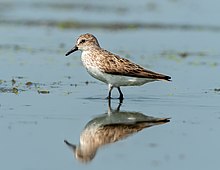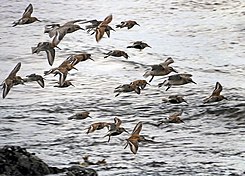
Back خواضات Arabic Кулікі (падатрад) Byelorussian পানিকাটা পাখি Bengali/Bangla Ocell limícola Catalan Bahňáci Czech Vadefugle Danish Vadbirdo Esperanto Aves limícolas Spanish پرندگان کنارآبزی Persian Limicole French
| Waders Temporal range:
| |
|---|---|

| |
| Semipalmated sandpiper (Calidris pusilla) | |
| Scientific classification | |
| Domain: | Eukaryota |
| Kingdom: | Animalia |
| Phylum: | Chordata |
| Class: | Aves |
| Clade: | Neoaves |
| Order: | Charadriiformes |
| Groups included | |
| |
| Cladistically included but traditionally excluded taxa | |

Waders or shorebirds are birds of the order Charadriiformes commonly found wading along shorelines and mudflats in order to forage for food crawling or burrowing in the mud and sand, usually small arthropods such as aquatic insects or crustaceans. The term "wader" is used in Europe, while "shorebird" is used in North America, where "wader" may be used instead to refer to long-legged wading birds such as storks and herons.
There are about 210[1] species of wader, most of which live in wetland or coastal environments. Many species of Arctic and temperate regions are strongly migratory, but tropical birds are often resident, or move only in response to rainfall patterns. Some of the Arctic species, such as the little stint, are amongst the longest distance migrants, spending the non-breeding season in the southern hemisphere.
Many of the smaller species found in coastal habitats, particularly but not exclusively the calidrids, are often named as "sandpipers", but this term does not have a strict meaning, since the upland sandpiper is a grassland species.
The smallest member of this group is the least sandpiper, small adults of which can weigh as little as 15.5 grams (0.55 oz) and measure just over 13 centimetres (5 inches). The largest species is believed to be the Far Eastern curlew, at about 63 cm (25 in) and 860 grams (1 pound 14 ounces), although the beach thick-knee is the heaviest at about 1 kg (2 lb 3 oz).
- ^ G.C. Boere, C.A. Galbraith and D.A. Stroud (2006). "Waterbirds around the world" (PDF). Joint Nature Conservation Committee. Archived from the original (PDF) on 2014-06-16. Retrieved 2018-07-25.



